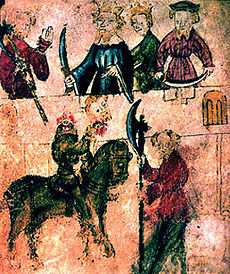
Guisarme
Encyclopedia


Pole weapon
A pole weapon or polearm is a close combat weapon in which the main fighting part of the weapon is placed on the end of a long shaft, typically of wood, thereby extending the user's effective range. Spears, glaives, poleaxes, halberds, and bardiches are all varieties of polearms...
used in Europe
Europe
Europe is, by convention, one of the world's seven continents. Comprising the westernmost peninsula of Eurasia, Europe is generally 'divided' from Asia to its east by the watershed divides of the Ural and Caucasus Mountains, the Ural River, the Caspian and Black Seas, and the waterways connecting...
primarily between 1000-1400. Like many medieval polearms, the exact form of the weapon is hard to define from literary references and the identification of surviving weapons can be speculative. Two main modern schools of thought exist.
- Like most polearmsPole weaponA pole weapon or polearm is a close combat weapon in which the main fighting part of the weapon is placed on the end of a long shaft, typically of wood, thereby extending the user's effective range. Spears, glaives, poleaxes, halberds, and bardiches are all varieties of polearms...
the guisarme was developed by peasants by combining hand tools with long poles: in this case by putting a pruning hook onto a spearSpearA spear is a pole weapon consisting of a shaft, usually of wood, with a pointed head.The head may be simply the sharpened end of the shaft itself, as is the case with bamboo spears, or it may be made of a more durable material fastened to the shaft, such as flint, obsidian, iron, steel or...
shaft. While hooks are fine for dismounting horsemen from mounts, they lack the stopping power of a spear especially when dealing with static opponents. While early designs were simply a hook on the end of a long pole, later designs implemented a small reverse spike on the back of the blade. Eventually weapon makers incorporated the usefulness of the hook in a variety of different polearms and guisarme became a catch-all for any weapon that included a hook on the blade. This is exemplified by the terms bill-guisarmesBill (weapon)The bill is a polearm weapon used by infantry in medieval Europe.The bill is similar in size, function and appearance to the halberd, differing mainly in the hooked blade form...
, voulge-guisarmesVoulgethumb|VoulgesA voulge is a type of polearm that existed alongside the similar glaive in medieval Europe. Superficially, a voulge might strongly resemble a glaive, but there are some notable differences in construction...
, and glaive-guisarmesGlaiveA glaive is a European polearm weapon, consisting of a single-edged blade on the end of a pole. It is similar to the Japanese naginata and the Chinese Guan Dao....
. - An alternative definition is given by Ewart OakeshottEwart OakeshottEwart Oakeshott was a British illustrator, collector, and amateur historian who wrote prodigiously on medieval arms and armour. He was a Fellow of the Society of Antiquaries, a Founder Member of the Arms and Armour Society, and the Founder of the Oakeshott Institute...
in his book European Weapons and Armour. He sees the guisarme as a "crescent shaped double socketed axe" on a long shaft. His primary reason is the use of the term "giserne" and axe interchangeably for the same weapon in the poem Sir Gawain and the Green KnightSir Gawain and the Green KnightSir Gawain and the Green Knight is a late 14th-century Middle English alliterative romance outlining an adventure of Sir Gawain, a knight of King Arthur's Round Table. In the poem, Sir Gawain accepts a challenge from a mysterious warrior who is completely green, from his clothes and hair to his...
. Strengthening his view are the illustrations in the original manuscript which clearly show Sir Gawain with a long crescent shaped axe (see right).

